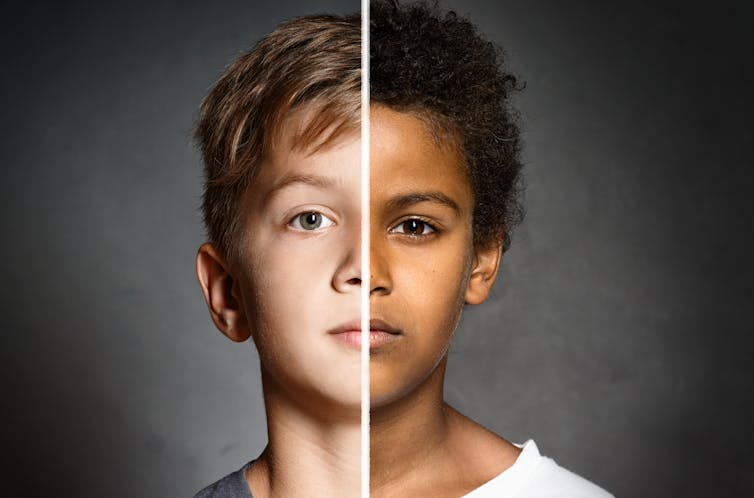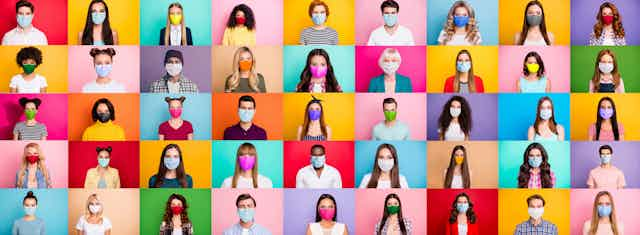Wearing a face mask is a COVID-19 infection control staple. Many states, provinces and municipalities now mandate the use of masks in indoor public spaces to prevent viral spread. Over 90 per cent of American adults wear them, and some are double masking.
But how do face masks affect social interactions?
It turns out we are not only less able to recognize one another, but we also see each other as less human. It is harder to recognize emotions correctly and we tend to over-perceive anger. Physical masks may even exacerbate racial bias.
Parts of a whole
Masks fundamentally alter face perception, making facial identification less accurate. They disrupt holistic processing, so that instead of a unified whole, the face breaks down into a collection of separate features: two eyes, eyebrows, a nose, mouth and chin.
“If your car differed from the other cars in the parking lot by just a couple of millimetres or centimetres, you would never find it,” says social psychologist Kurt Hugenberg. “But finding your friend in a crowd is no problem” — thanks to holistic processing.
It allows us to tell each other apart easily, even though our faces are objectively extremely similar, Hugenberg says. It also lets us extract other signals, like facial expressions. “And finally, this sort of holistic face processing sends a signal that a person is a person. It provides this flash of recognition of the humanness of another person,” says Hugenberg.
“When we undermine that ability to recognize a face as a face,” says Hugenberg, “it takes away — at least in part — some of its humanness.”
Discriminating faces
This type of dehumanization also affects our perception of people of other races — something called the other-race effect. People process faces of their own race more holistically than those of other races, so they are better at recognizing and remembering them.
Social psychologist Nicholas Camp measured how white participants responded to white and Black faces. Even when participants saw very similar white faces, their brains reacted as if it was a new stimulus every time. However, even if Black faces were very different, “they responded as if they had already seen that person before,” Camp says.
“That happens early in perception,” says Camp. He notes that viewing others as interchangeable is the first step towards stereotyping and discrimination.
There are two primary explanations for the other-race effect: exposure and socialization. People may have more experience with faces in their own race group due to segregation, so the brain gets better at identifying them. Or people care more about their own social group, and the brain prioritizes understanding those faces more than others. Both of these processes likely drive this perceptual bias.
“De-individuation might relate to how fear spreads across individuals,” Camp says. “If you’re not really distinguishing between different members of racial out groups, it could be that negative associations or experiences just spill over when you encounter other people.” This infectious psychology may allow cultural stereotypes to bias perceptual processes.
Recognizing emotion
Psychologist Amy Halberstadt studies racialized emotion recognition. She trained child actors to express very specific emotions and found that teachers falsely interpreted the Black children as angry more than the white children — even when they were not showing any anger at all.
While different ethnic groups frequently misperceive emotions of other groups, this over-perception of aggression in Black faces reflects a systemic bias that likely arises out of a cultural fear of Black anger built by a long history of European American scare tactics and fear mongering. This stereotype reinforces racist patterns of thinking about Black people as less human or more frightening.

During the pandemic, face masks may only worsen emotional recognition errors. Psychologist Claus-Christian Carbon discovered that face masks not only reduce accuracy of facial readings, but create specific confusions: disgusted faces are often interpreted as angry and other emotions, like happiness and sadness, frequently appear neutral.
“For people who think that they know what other people are thinking, the masks are going to exacerbate the mistakes that they make,” says Halberstadt, potentially leading to more racist emotional bias.
But if we can acknowledge that the masks are inhibiting our perception, adds Halberstadt, they could give us the opportunity to ask more questions.
Hugenberg also notes that motivation can mitigate the other-race effect. Simply tell white participants: “Be sure to pay attention to what distinguishes between racial out group members.” Instructions like that improve recognition of other-race faces. This finding suggests that simply trying harder can combat perceptual racism.
Face masks are a necessary part of our everyday lives in the pandemic. As a clinical researcher, I often have confusing, socially awkward exchanges with masked participants. My timing feels off or I can’t quite understand them. But now I see masks as a reminder to interact with more humility, ask questions, and make a conscious effort to see the human beyond the mask.

